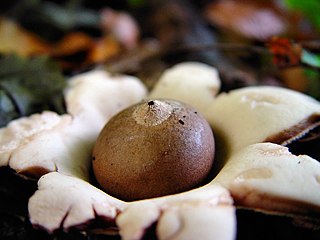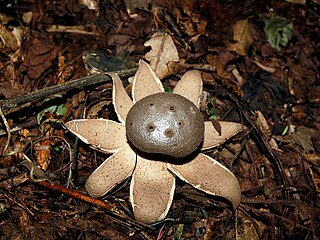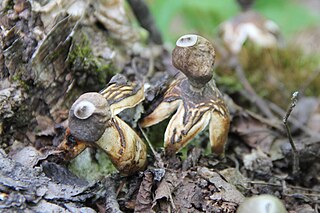
Geastrales is an order of gasterocarpic basidiomycetes (fungi) that are related to Cantharellales. The order contains the single family Geastraceae, which includes the "earthstars" formerly placed in Lycoperdales, or Phallales.

Geastrum is a genus of puffball-like mushrooms in the family Geastraceae. Many species are known commonly as earthstars.

Geastrum fornicatum, common name known as the acrobatic earthstar or the arched earthstar, is an inedible species of mushroom in the family Geastraceae. Like other earthstar mushrooms, the thick outer skin splits open at maturity to expose the spore sac to the elements; the specific epithet fornicatum refers to the arched shape of the rays which extend downwards to rest on the mycelial sac and elevate the spore sac.

Myriostoma is a fungal genus in the family Geastraceae. Basidiocarps resemble earthstars, but the spore sac is supported by multiple columns and has multiple ostioles instead of a single, apical ostiole. Until 2017, the genus was thought to be monotypic with a single, widespread species, Myriostoma coliforme. Recent research has, however, shown that at least six species occur worldwide.

Chorioactis is a genus of fungi that contains the single species Chorioactis geaster. The mushroom is commonly known as the devil's cigar or the Texas star in the United States, while in Japan it is called kirinomitake (キリノミタケ). This extremely rare mushroom is notable for its unusual appearance and disjunct distribution; it is found only in select locales in Texas and Japan. The fruit body, which grows on the stumps or dead roots of cedar elms or dead oaks, somewhat resembles a dark brown or black cigar before it splits open radially into a starlike arrangement of four to seven leathery rays. The interior surface of the fruit body bears the spore-bearing tissue known as the hymenium, and is colored white to brown, depending on its age. The fruit body opening can be accompanied by a distinct hissing sound and the release of a smoky cloud of spores.

Geastrum saccatum, commonly known as the rounded earthstar, is a species of mushroom belonging to the genus Geastrum. It has a worldwide distribution and is found growing on rotting wood. It is considered inedible by mushroomers because of its bitter taste. It is a common mushroom, but collections are at their peak during late summer. The opening of the outer layer of the fruiting body in the characteristic star shape is thought to be due to a buildup of calcium oxalate crystals immediately prior to dehiscence. G. saccatum is distinguished from other earthstars by the distinct circular ridge or depression surrounding the central pore. In Brazil, its common name translates to "star of the land".
Geastrum entomophilum is an inedible species of mushroom belonging to the genus Geastrum, or earthstar fungi. Found in northeast Brazil in 2008, the species was found with beetles inhabiting the spore sac, likely contributing to spore dissemination.

Geastrum fimbriatum, commonly known as the fringed earthstar or the sessile earthstar, is an inedible species of mushroom belonging to the genus Geastrum, or earthstar fungi. First described in 1829, the species has a widespread distribution, and is found in Asia, Europe, and the Americas. It is distinguished from other earthstars by the delicate fibers that line the circular pore at the top of its spore sac.

Geastrum pectinatum is an inedible species of mushroom belonging to the earthstar family of fungi. Although young specimens are spherical, fruit body development involves the outer layer of tissue splitting open like a star into 7 to 10 pointed rays that eventually bend back to point downward, revealing a small – 1 to 2.5 cm broad – spore sac. The spore sac is supported by a small radially wrinkled stalk. There is a distinct conical opening (peristome) at the top of the spore sac that is up to 8 mm (0.3 in) long. It is commonly known as the beaked earthstar or the beret earthstar, in reference to the shape of the spore sac and its prominent, protruding peristome. The mass of spores and surrounding cells within the sac, the gleba, is dark-brown, and becomes powdery in mature specimens. Spores are spherical, measuring 4 to 6 micrometers in diameter, with warts on their surfaces. Although uncommon, Geastrum pectinatum has a cosmopolitan distribution, and has been collected in various locations in Europe, North and South America, Asia, Australia and Africa, where it grows on the ground in open woods. Like several other earthstars, crystals of calcium oxalate are found on G. pectinatum, and are thought to be involved in fruit body maturation.

Astraeus hygrometricus, commonly known as the hygroscopic earthstar, the barometer earthstar, or the false earthstar, is a species of fungus in the family Diplocystaceae. Young specimens resemble a puffball when unopened. In maturity, the mushroom displays the characteristic earthstar shape that is a result of the outer layer of fruit body tissue splitting open in a star-like manner. The false earthstar is an ectomycorrhizal species that grows in association with various trees, especially in sandy soils. A. hygrometricus was previously thought to have a cosmopolitan distribution, though it is now thought to be restricted to Southern Europe, and Astraeus are common in temperate and tropical regions. Its common names refer to the fact that it is hygroscopic (water-absorbing), and can open up its rays to expose the spore sac in response to increased humidity, and close them up again in drier conditions. The rays have an irregularly cracked surface, while the spore case is pale brown and smooth with an irregular slit or tear at the top. The gleba is white initially, but turns brown and powdery when the spores mature. The spores are reddish-brown, roughly spherical with minute warts, measuring 7.5–11 micrometers in diameter.

Astraeus is a genus of fungi in the family Diplocystaceae. The genus, which has a cosmopolitan distribution, contains nine species of earthstar mushroom. They are distinguished by the outer layer of flesh (exoperidium) that at maturity splits open in a star-shape manner to reveal a round spore sac. Additionally, they have a strongly hygroscopic character—the rays will open when moist, but when hot and dry will close to protect the spore sac. Species of Astraeus grow on the ground in ectomycorrhizal associations with trees and shrubs. Despite their similar appearance to the Geastrum earthstars Astraeus is not closely related.

Geastrum triplex is a fungus found in the detritus and leaf litter of hardwood forests around the world. It is commonly known as the collared earthstar, the saucered earthstar, or the triple earthstar—and less commonly by the alternative species name Geastrum indicum. It is the largest member of the genus Geastrum and expanded mature specimens can reach a tip-to-tip length of up to 12 centimeters (4.7 in).

The gasteroid fungi are a group of fungi in the Basidiomycota. Species were formerly placed in the obsolete class Gasteromycetes Fr., or the equally obsolete order Gasteromycetales Rea, because they produce spores inside their basidiocarps rather than on an outer surface. However, the class is polyphyletic, as such species—which include puffballs, earthstars, stinkhorns, and false truffles—are not closely related to each other. Because they are often studied as a group, it has been convenient to retain the informal (non-taxonomic) name of "gasteroid fungi".

Geastrum jurei is a species of fungus in the Geastrales, or earthstar fungi. It is known only from Algarrobo, in the Valparaíso province of Chile. It is a fornicate species of earthstar, meaning that the tips of the rays press down so as to raise the spherical spore sac into the air.
Geastrum leptospermum is a species of fungus in the family Geastraceae. It was first described scientifically by American mycologist George F. Atkinson in 1903. The fungus produces small fruit bodies and grows in mosses on tree trunks.

Geastrum quadrifidum, commonly known as the rayed earthstar or four-footed earthstar, is an inedible species of mushroom belonging to the genus Geastrum, or earthstar fungi. First described scientifically by Christian Hendrik Persoon in 1794, G. quadrifidum is a cosmopolitan—but not common—species of Europe, the Americas, Africa, Asia, and Australasia. The fungus is a saprobe, feeding off decomposing organic matter present in the soil and litter of coniferous forests.

Geastrum welwitschii is a species of fungus in the earthstar family. When young and unopened, the fruit bodies resemble small spheres lying in the soil. As the mushroom matures, the thick leathery outer layer of tissue splits star-like to form a number of fleshy arms, which curve downward to reveal the inner spore sac that contains the fertile tissue known as the gleba. The spore sac has a narrow grooved opening at the top where the spores are released. Fully expanded, the fruit bodies are up to 35 mm (1.4 in) wide and 58 mm (2.3 in) tall. First collected from Spain in the mid-19th century, the fungus is distributed in Europe, North America, and Bermuda.

Myriostoma coliforme is a fungal species in the family Geastraceae. Basidiocarps resemble earthstars, but the spore sac is supported by multiple columns and has multiple ostioles instead of a single, apical ostiole. In the UK, its recommended English name is pepper pot. It has also been called "salt-shaker earthstar". The fungus has a north temperate distribution, but was formerly thought to be more widespread due to confusion with related Myriostoma species. Myriostoma coliforme is an uncommon species and appears on the Red Lists of 12 European countries. In 2004 it was one of 33 species proposed for protection under the Bern Convention by the European Council for Conservation of Fungi.

Geastrum minimum or tiny earthstar is an inedible species of mushroom belonging to the genus Geastrum. Although rare, it is widespread in Europe, where it occurs in a range of habitats. It is a priority species in the UK, where it has been found in the sand dunes at Holkham National Nature Reserve.

Scleroderma polyrhizum, commonly known as the star earthball or dead man's hand, is a basidiomycete fungus and a member of the genus Scleroderma, or "earthballs". Found in dry, sandy soils, this species begins completely buried before slowly forcing the soil aside as it cracks apart to form a rough, star-shaped body with a diameter of 12–15 cm (4.7–5.9 in). At the center is the dark, brownish spore mass. Widely distributed wherever the soil and climate are favorable, it is known from Asia, Europe, and the Americas.
















